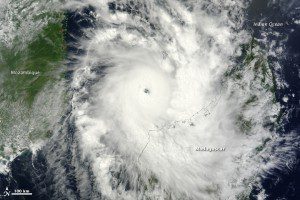
The Moderate Resolution Imaging Spectroradiometer on NASA's Terra satellite acquired this image of Cyclone Hellen on March 30 in the middle of the storm's rapid intensification. The storm had a distinct open eye and a classic tight circular shape. Its outer bands were already over northwestern Madagascar.
On March 30, 2014, the outlook appeared grim for northwestern Madagascar. Tropical cyclone Hellen spun offshore, rapidly gaining strength with a track destined to bring it ashore.
The day started with the storm being the equivalent of a Category 2 storm with winds of 170 kilometers per hour (100 miles per hour or 90 knots). Twelve hours later, winds reached 240 kilometers per hour (150 miles per hour or 130 knots), making it a strong Category 4 storm.
Fortunately, Hellen weakened substantially not long before it made landfall, minimizing the damage. Just before landfall, warning bulletins advised residents to prepare for periods of heavy rain and wind and a possible storm surge of 2 meters (7 feet).
Image courtesy of NASA.

